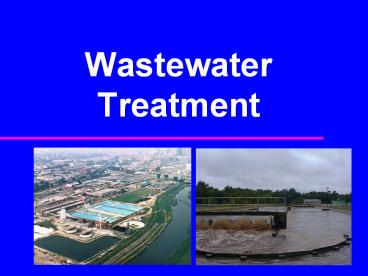Wastewater%20Treatment - PowerPoint PPT Presentation
Title:
Wastewater%20Treatment
Description:
1972: Federal Water Pollution Control Act ... Thickening. gravity, flotation. Digestion. aerobic, anaerobic. Mechanical Dewatering ... – PowerPoint PPT presentation
Number of Views:437
Avg rating:3.0/5.0
Title: Wastewater%20Treatment
1
- Wastewater Treatment
2
(No Transcript)
3
Municipal WW Management Systems
Sources of Wastewater
Processing at the Source
Wastewater Collection
Reuse/Disposal
Treatment
Transmission and Pumping
4
Sources Types of WW
- Domestic Wastewater
- from residences, commercial institutional
- flows 70-90 of water supplied
- Industrial Wastewater
- highly dependent on industry
- Infliltration/Inflow
- enters through leaks, foundation drains, etc.
- Stormwater
- for combined sewers - largely in older cities
5
Typical WW Characteristics
6
1972 Federal Water Pollution Control Act
- PL 92-500 subsequently amended and now called the
Clean Water Act - established water quality goals fishable
swimmable and timetable - established National Pollution Discharge
Elimination System (NPDES) - construction grants for WW treatment
- required secondary treatment (30/30)
- 30 mg/L BOD5
- 30 mg/L TSS
7
TREATMENT CLASSIFICATION
- PRIMARY
- Removal of solids
- SECONDARY
- Removal of organics
- TERTIARY
- Removal of nutrients (N and P)
8
Conventional WW Treatment
9
Preliminary Treatment
- To remove materials that will interfere with
subsequent treatment - Coarse Screening (bar racks)
- Medium Screening
- Comminution
- Flow measuring
- Pumping
- Grit removal
- Pre-aeration
10
Bar Racks
- Metal bars spaced a few cm apart across water
flow - mechanical or manually cleaned
- size of unit set by approach velocity
- 0.6-1.0 m/s for mechanically cleaned
- 0.3-0.7 m/s for manually cleaned
- see Fig 10.4 and example 10.2 on pg. 311
11
(No Transcript)
12
Grit Removal
- Grit chambers intended to remove sand, cinders,
gravel that may enter system by cracks in pipes,
inflow etc. - Grit can cause excess wear in pipes and pumps
- small sedimentation tanks designed with the help
of Stokes Law - no organics removal
13
Grit Chamber
14
Primary Sedimentation
- Purpose to remove suspended solids (smaller than
grit, and less harmful) - Typical efficiency
- 67 TSS removal
- 33 BOD removal
- Design parameters
- overflow rate
- weir loading rate
- detention time
Primary effluent is largely composed of soluble
and colloidal organics which can be converted to
settleable microbial solids and CO2 by biological
treatment
15
Primary Sedimentation
- Primary Treatment
- Removes 50 of suspended solids
16
Primary Sed. Tank
17
Primary Clarifier Center Feed
18
Secondary Treatment
- Generally includes some biological process plus
secondary clarification - Required under PL92-500
- Converts soluble and colloidal organic materials
to biomass and CO2
19
Biological Treatment
- Suspended Growth
- Activated Sludge
- Conventional, Extended Aeration, Contact
Stabilization - Aerated lagoons
- Aerobic digestion
- Attached Growth
- Trickling Filters
- Rotating Biological Contactors
20
Suspended Growth Systems
Activated Sludge!
Sludge
21
Attached Growth Trickling Filters
Rotary Distributor
Rocks or Plastic Media
Air
Underdrain
With rocks, depth is limited to 2-3 m because of
oxygen needs
22
Rotating Biological Contactors
- Drum diameters are typically 10-12 ft.
- Rotation speed 1.5 rpm
- May be in several stages
- No flow recycle
- Requires piloting
23
Secondary Clarifier
24
Sludge Disposal
- Thickening
- gravity, flotation
- Digestion
- aerobic, anaerobic
- Mechanical Dewatering
- Vacuum filtration, centrifugation, pressure
filtr. - Disposal
- land application, burial, incineration
25
Anaerobic Digestion
- Sludge held without aeration for 10-90 days
- Process can be accelerated by heating to 35-40oC
- These are called High Rate Digestors (10-20 days)
- Advantages
- low solids production
- useable methane gas produced
- Disadvantages
- high capital costs
- susceptibility to shocks and overloads
26
Sludge Dewatering
- Sludge drying beds
- historically the most common
- sand bed, 15-30 days, evaporation seepage
- Vacuum Filtration
- cylindrical rotating drum covered with fabric
- submerged with applied vacuum
- Continuous belt filter presses (follows)
- Plate pressure filters
- vertical plates mounted on a frame
27
Belt Filter Press (Komline-Sanderson)































